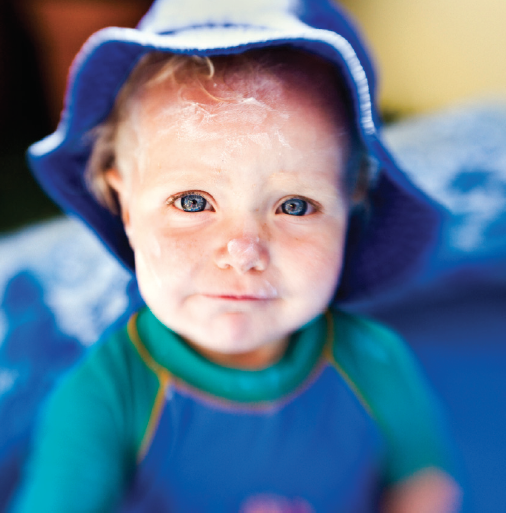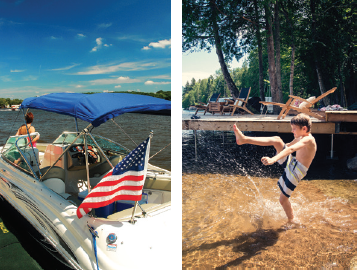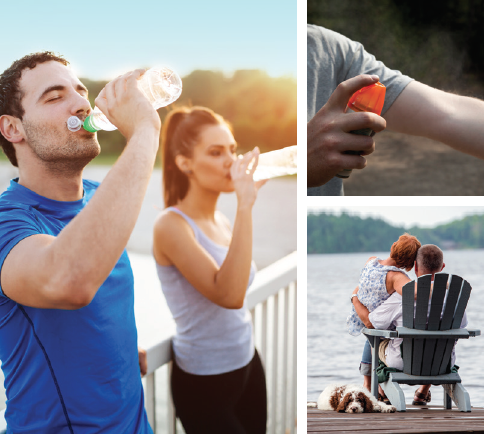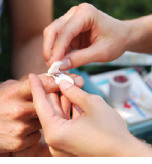
Ah, summertime! As the Smith Mountain Lake air warms and the skies above clear to brilliant blue, everyone has visions of sunny months ahead filled with outdoor activities. But whether you’re hitting the water for an epic wakeboard run or just floating in a quiet cove, a variety of hazards lurk that can sideline plans for fun and relaxation.
However, you can mitigate summer fun suckers by being prepared for some of the season’s the most common ailments and taking a few preventive measures. Be the hero in your family by following these tips to help keep the good times rolling at Smith Mountain Lake.
Be prepared
Well-equipped first-aid kits are a must-have in everyone’s home, as well as in cars and boats. Before the start of summer merriment, the American Red Cross recommends a review of first-aid kit inventories to ensure that all the bandages and other first-aid necessities are up to date (see sidebar on next page).
Additional items to consider having readily available in the house and on the dock include ice packs (for those pesky sprains from too much hiking or wakeboarding), over-the-counter pain relievers such as acetaminophen or ibuprofen, an antihistamine (such as Benadryl) for mild allergies that produce runny noses and itchy eyes, and calamine lotion for nuisances such as bug bites and rashes.
It’s also a good idea to stock up on items to combat the effects of overindulging (like after that third hot dog at the 4th of July festivities), including ginger ale, peppermint tea, antacids and sodium bicarbonate (found in Alka-Seltzer).
Beware the bugs!
We humans are not the only ones who enjoy the great outdoors. Warmer months encourage the breeding and swarming of insects such as mosquitos, bees and ticks. Regarding the vampires of the insect world—mosquitos—the Centers for Disease Control and Prevention recommend a multi-effort approach to include wearing long-sleeved pants and shirts when outdoors and utilization of mosquito repellents.
Bee stings are another common summer insect-related malady. To treat minor stings with no allergic reaction, the Mayo Clinic recommends using tweezers to remove the stinger as soon as possible, washing the area and applying a cold compress, then treating with cortisone cream or calamine lotion to reduce itching.
Note that some people can be highly allergic to insect stings and multiple stings increase the chances of a severe allergic reaction. Make sure you know the location of the closest medical care facility before an emergency happens, especially if you are vacationing at Smith Mountain Lake and aren’t particularly familiar with the region. During an emergency, time is critical; when in doubt, it’s always wise to call 911.

Too much fun in the sun
A healthy amount of time spent in the sunlight can help the absorption of vitamin D—sometimes called the “sunshine vitamin.” Sufficient vitamin D is an important component of developing and maintaining strong, healthy bones, and sunlight delivers this powerful nutrient.
However, overexposure to the sun’s rays without proper protection will damage skin and can produce red, irritated swelling commonly known as a sunburn. A fun-filled day out on the water can turn into a not-so-comfortable evening if the right precautions aren’t taken.
 Today’s sunscreens offer necessary protection and enable us to stay outside for extended periods of time. Dermatologists recommend using a broad spectrum sunblock with a sun protection factor (SPF) of at least 30. Of utmost importance is the reapplication of sunblock. Reapply at least once an hour because most sunblocks can easily wear or wash off—particularly important if you’re in and out of the lake.
Today’s sunscreens offer necessary protection and enable us to stay outside for extended periods of time. Dermatologists recommend using a broad spectrum sunblock with a sun protection factor (SPF) of at least 30. Of utmost importance is the reapplication of sunblock. Reapply at least once an hour because most sunblocks can easily wear or wash off—particularly important if you’re in and out of the lake.
And don’t forget to apply to often-overlooked body parts that are susceptible to sunburns such as feet, the back of your neck and ears, and the bridge of your nose. If outside activities result in overexposure to sunlight, the Skin Care Foundation recommends a few things to relieve the pain of a sunburn:
- If you’re near a cold pool or the lake, take a quick dip to cool your skin, but only for a few seconds so you don’t prolong your exposure. Then cover up and get out of the sun immediately;
- While skin is still damp, use a gentle moisturizing lotion (but not petroleum or oil-based ointments, which may trap the heat and make the burn worse);
- At the first sign of sunburn, taking a nonsteroidal anti-inflammatory drug (NSAID), such as ibuprofen, naproxen or aspirin, can help with discomfort and inflammation;
- Burns draw fluid to the skin’s surface and away from the rest of the body, so you may become dehydrated. It’s important to rehydrate by drinking extra liquids, including water and sports drinks.
- Seek medical help if you or anyone in your group has severe blistering over a large portion of the body, fever and chills, or is woozy or confused.

Finally, always keep in mind that sunny days spent enjoying Smith Mountain Lake—relaxing on a dock, skiing, paddleboarding—can feel deceptively cool and breezy. Frolicking in the water is not the same as consuming good ol’ H2O.
To avoid dehydration, drink plenty of water throughout the day. A cooler filled with bottled water or a pitcher filled with ice, water, and sliced fruit will entice you, your friends, and family to drink up.
Follow these tips and enjoy a safe and healthy summer season at SML!
Symptoms of an Allergic Reaction
Seek immediate emergency medical care if someone is stung by any insect and exhibits any of these reactions:
 Trouble breathing
Trouble breathing- Hives that appear as a red, itchy rash and spread to areas beyond the sting
- Swelling of the face, throat or mouth tissue
- Wheezing or trouble swallowing
- Restlessness and anxiety
- Rapid pulse
- Dizziness or a sharp drop in blood pressure
Source: webmd.com
 First-aid Essentials
First-aid Essentials
The American Red Cross recommends the following first-aid kit contents:
- 2 absorbent compress dressings (5 x 9 inches)
- 25 adhesive bandages (assorted sizes)
- 1 adhesive cloth tape
(10 yards x 1 inch) - 5 antibiotic ointment packets (approximately 1 gram)
- 5 antiseptic wipe packets
- 2 packets of aspirin
(81 mg each) - 1 blanket (space blanket)
- 1 breathing barrier
(with one-way valve) - 1 instant cold compress
- 2 pair of non-latex gloves
(size: large) - 2 hydrocortisone ointment packets (approximately 1 gram each)
- Scissors
- 1 roller bandage
(3 inches wide) - 1 roller bandage
(4 inches wide) - 5 sterile gauze pads
(3 x 3 inches) - 5 sterile gauze pads
(4 x 4 inches) - Oral thermometer
(non-mercury/non-glass) - 2 triangular bandages
- Tweezers
For more tips, visit redcross.org.
